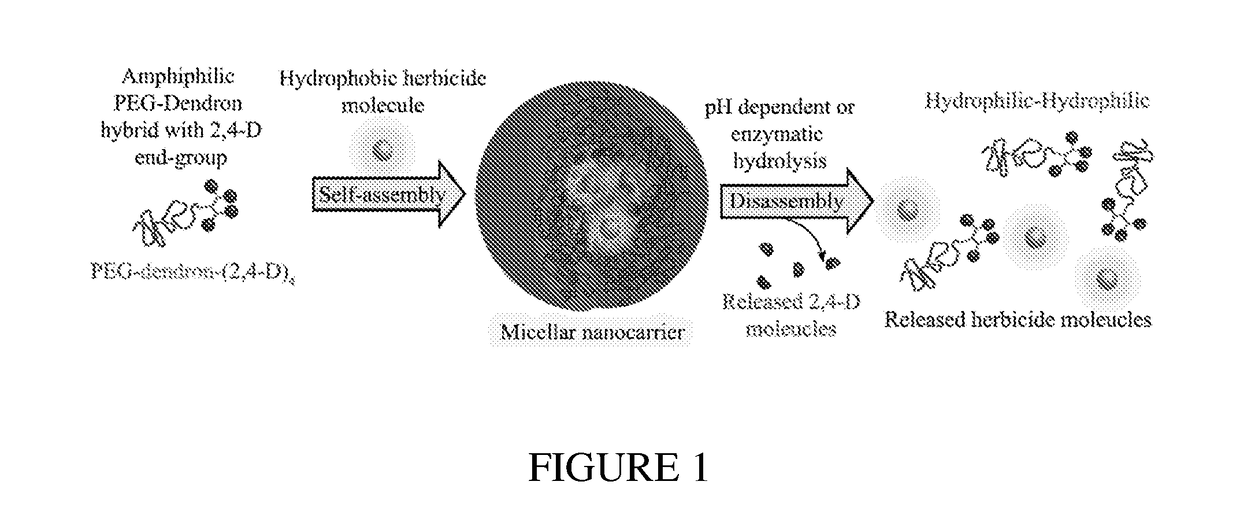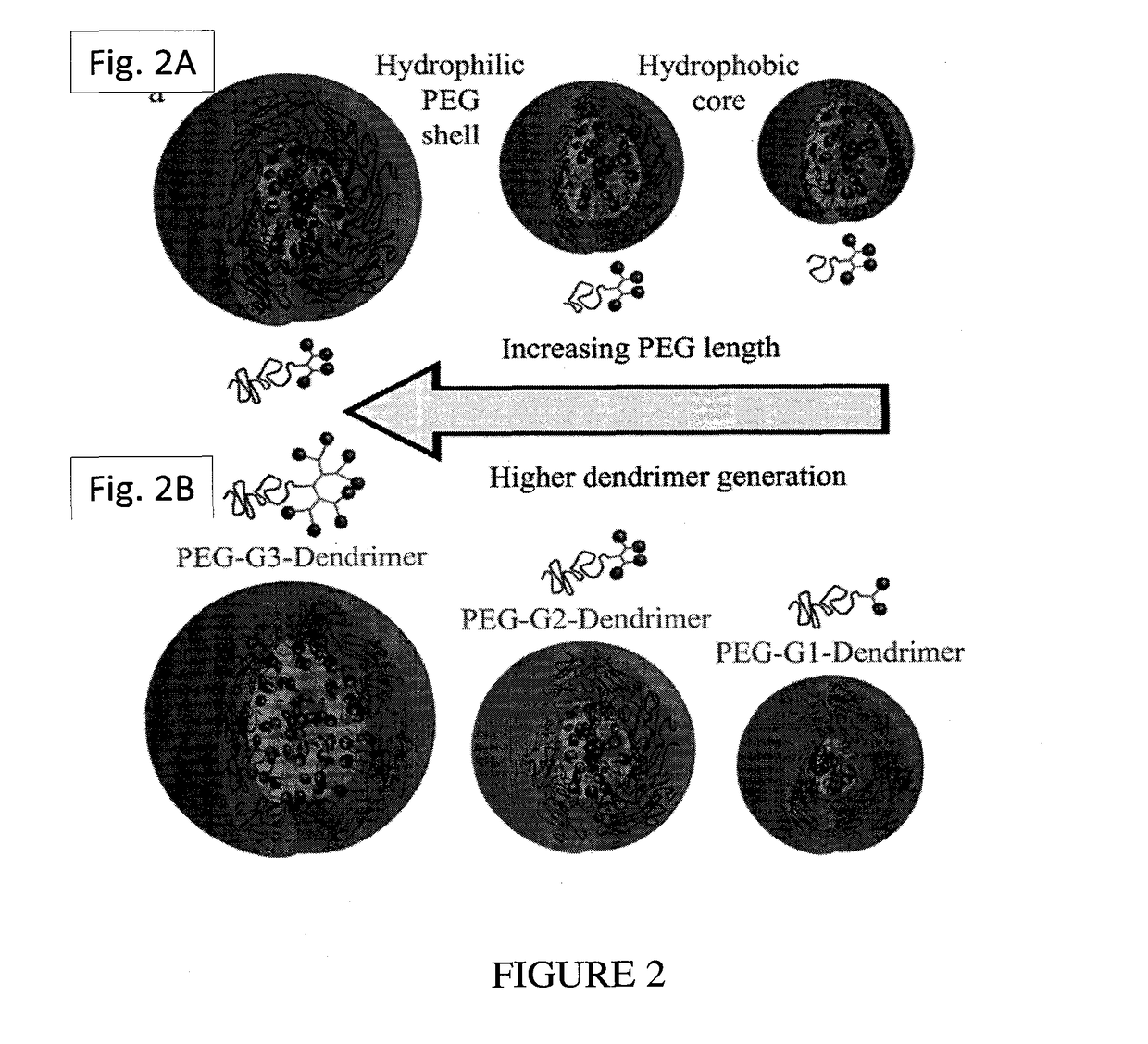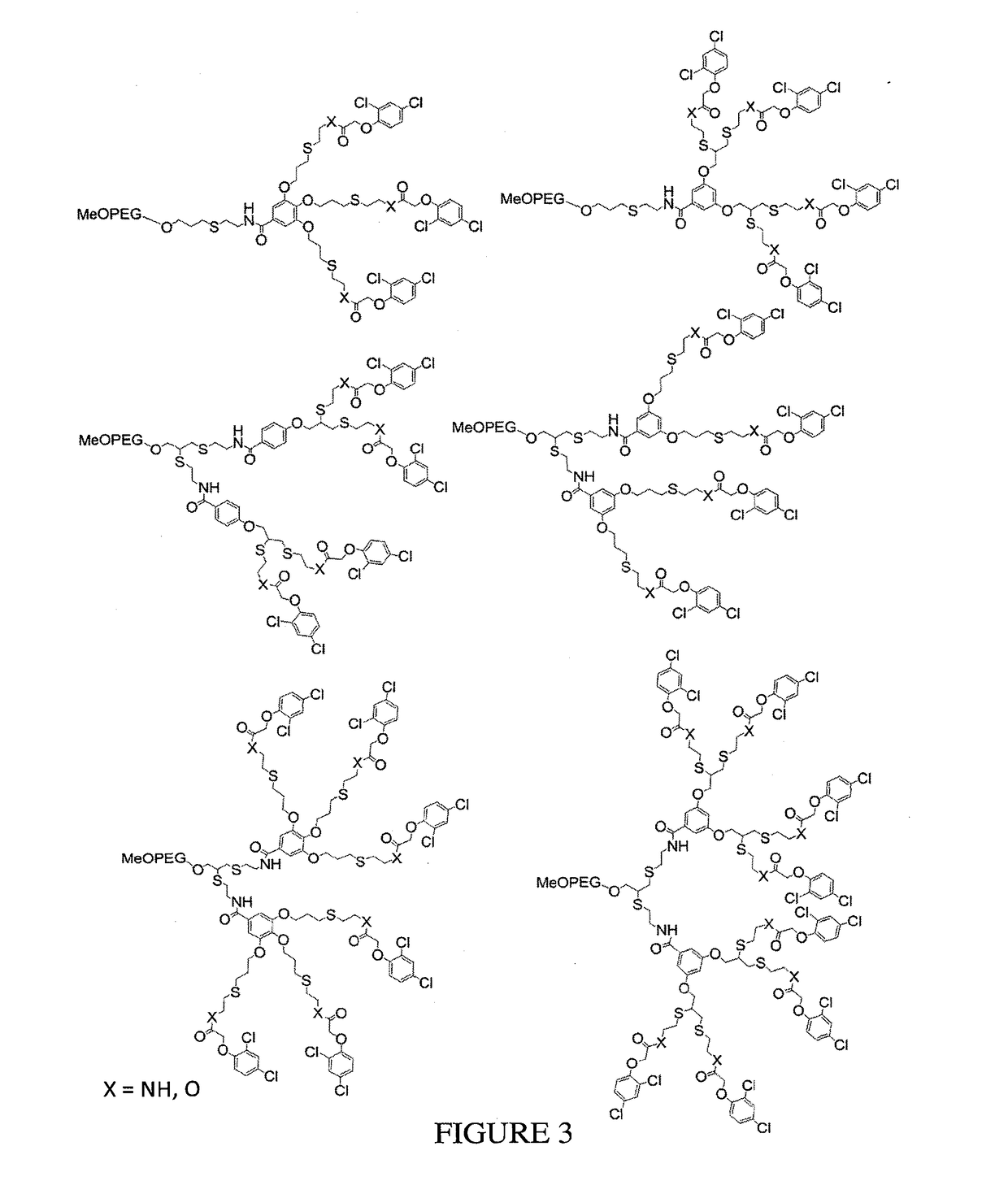AGROCHEMICAL DELIVERY SYSTEM BASED ON ENZYME- OR pH- RESPONSIVE AMPHIPHILIC PEG-DENDRON HYBRIDS
a technology of amphiphilic peg-dendron and hybridization, applied in the field of enzyme- or ph-responsive amphiphilic hybrid delivery system, can solve the problems of increased herbicide application, increased herbicide application, and high undesired application of large amounts of persistent herbicides, and achieve unprecedented control of the degree of loading and release of active herbicides
- Summary
- Abstract
- Description
- Claims
- Application Information
AI Technical Summary
Benefits of technology
Problems solved by technology
Method used
Image
Examples
example 1
and Methods
[0178]Materials:
[0179]Poly (Ethylene Glycol) methyl ether (2 kDa, 5 kDa and 10 kDa), 2-(Boc-amino)-ethanethiol (97%), 2,2-dimethoxy-2-phenylacetophenone (DMPA, 99%), Penicillin G Amidase from Escherichia coli (PGA), Esterase from porcine liver (PLE), Allyl bromide (99%), 4-Nitrophenol (99.5%), N,N′-dicyclohexylcarbodiimide (DCC, 99%), Sephadex® LH20 and dry DMF were purchased from Sigma-Aldrich. Cystamine hydrochloride (98%), potassium hydroxide and DIPEA were purchased from Merck. Trifluoroacetic acid (TFA) was purchased from Alfa Aesar and phenyl acetic acid was purchased from Fluka. Silica Gel 60 Å, 0.040-0.063 mm, sodium hydroxide and all solvents were purchased from Bio-Lab and were used as received. All solvents are HPLC grade. Deuterated solvents for NMR were purchased from Cambridge Isotope Laboratories, Inc.
[0180]Instrumentation:
[0181]HPLC: All measurements were recorded on a Waters Alliance e2695 separations module equipped with a Waters 2998 photodiode array de...
example 2
of Amphiphilic PEG-Dendron Hybrids
[0197]2,4-D was used as a preliminary model compound, which is conjugated to the hydroxy end-groups of the dendron through ester linkages (Scheme 1). These esters can potentially be cleaved by either pH-dependent or enzymatic hydrolysis, to release the parent active herbicide 2,4-D.
[0198]The utilization of ester linkages from either primary or secondary hydroxyls enables further control over the hydrolysis rate in addition to the length of the PEG and dendrons' generation. The synthesis of a second-generation dendron with primary ester linkages and a third-generation dendron are as illustrated in Scheme 2.
example 3
of Alternative Amphiphilic PEG-Dendron Hybrids (1a-1c)
[0199]
[0200]In the above scheme, MeO-PEG-NH2 (compounds 2a-2c) is represented by the structure shown in Scheme 4.
[0201]The amphiphilic hybrids (1a-c) of the invention may be prepared by the process described in general Scheme 3 hereinabove. Briefly, the hybrid block copolymers are synthesized utilizing mono-methyl ether PEG-amine, 2a-c, as starting materials. Conjugation with an active ester of 3,5-bis(prop-2-yn-1-yloxy)benzoic acid, 3, yielded PEG-di-yne, 4a-c. The latter are further modified by thiol-yne reaction with N-Boc cysteamine, 5, to give tetra-functionalized PEG-dendrons, 6a-c, followed by deprotection of the Boc to yields PEG-tetra-amine, 7a-c. In the last step of the synthesis, the agrochemical compound, 8, is used to introduce the enzyme cleavable hydrophobic surface-groups.
[0202]The synthesized polymers and hybrids are characterized by 1H and 13C-NMR, GPC, IR and MALDI in order to confirm their structures.
General P...
PUM
| Property | Measurement | Unit |
|---|---|---|
| particle size | aaaaa | aaaaa |
| particle size | aaaaa | aaaaa |
| particle size | aaaaa | aaaaa |
Abstract
Description
Claims
Application Information
 Login to View More
Login to View More - R&D
- Intellectual Property
- Life Sciences
- Materials
- Tech Scout
- Unparalleled Data Quality
- Higher Quality Content
- 60% Fewer Hallucinations
Browse by: Latest US Patents, China's latest patents, Technical Efficacy Thesaurus, Application Domain, Technology Topic, Popular Technical Reports.
© 2025 PatSnap. All rights reserved.Legal|Privacy policy|Modern Slavery Act Transparency Statement|Sitemap|About US| Contact US: help@patsnap.com



